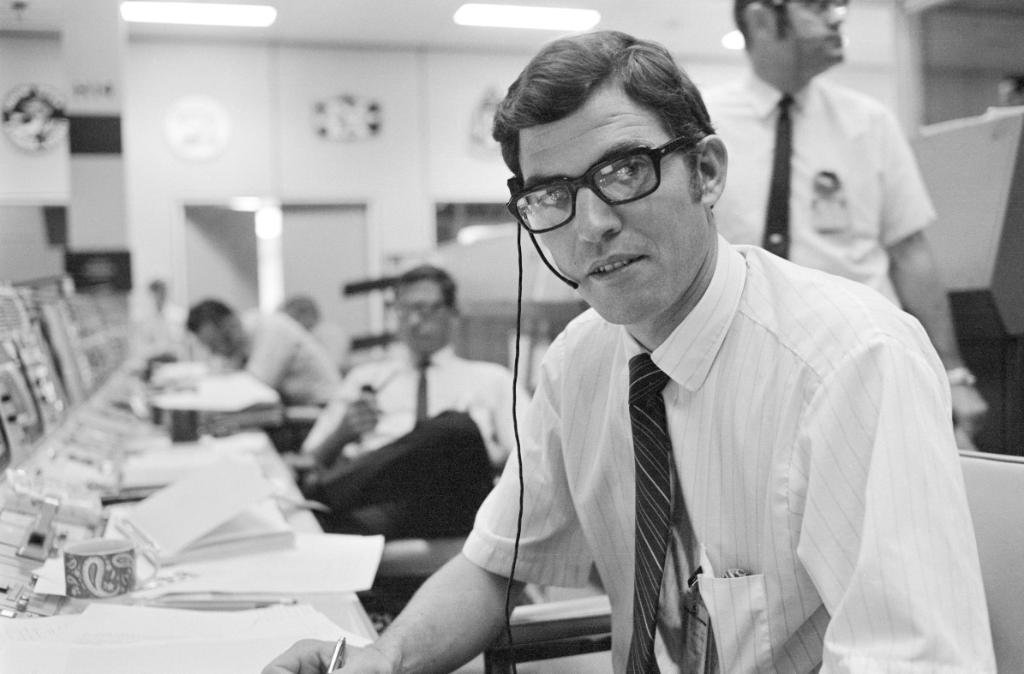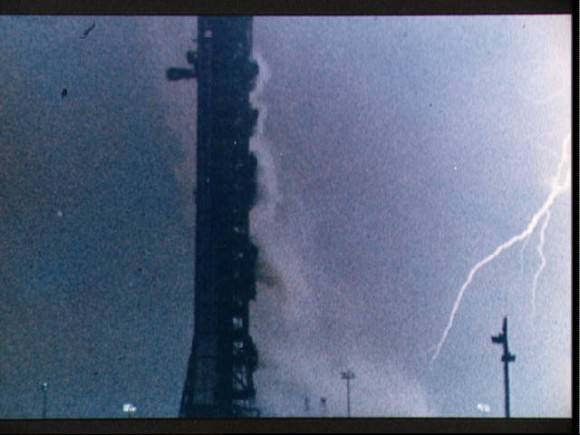On this day in history, on November 14, 1969, Apollo 12 successfully launched to the Moon. But it wasn’t without a little drama. The weather that day at Cape Canaveral in Florida was overcast with light rain and winds. However, at 11:22 am EST, the spacecraft, carrying astronauts Pete Conrad, Dick Gordon, and Alan Bean, blasted off into the clouds, in a seemingly perfect launch.
But thirty-seven seconds into launch, all hell broke loose.
“What the hell was that?” asked Gordon. Twenty seconds of confusion ensued, and then another disturbance occurred.
“Okay, we just lost the platform gang,” reported Conrad, “I don’t know what happened here. We had everything in the world drop out.”
The crew and Mission Control didn’t know what had happened, and only later determined the Saturn V rocket had been struck by lighting – twice.
Were it not for flight controller John Aaron, the mission might have been aborted. Aaron may be remembered more for being instrumental in helping to save Apollo 13, but the part he played in Apollo 12 was just as crucial.
When he saw the unusual telemetry readings from Apollo 12, he remembered a flight simulation that took place about a year earlier, where similar telemetry showed up. He recalled this simulated anomaly concerned an obscure system called Signal Conditioning Equipment (SCE), and remembered normal readings were restored by putting the SCE on its auxiliary setting, which meant that it would run even under low-voltage conditions.
So when he quickly called out the recommendation, “Flight, try SCE to ‘AUX'”, most of his mission control colleagues had no idea what he was talking about. Both the flight director and the CapCom asked him to repeat the recommendation. Pete Conrad’s response to the order was, “What the hell is that?”
Fortunately Alan Bean was familiar with the location of the SCE switch inside the capsule, and flipped it to auxiliary. Telemetry was immediately restored, allowing the mission to continue.
This was just one instance that earned Aaron the compliment of being called a “steely-eyed missile man,” the absolute highest of NASA compliments. And even today — among us geeks — the phrase “SCE to AUX” used to describe a situation where one narrowly averts a catastrophe by coming up with an ingenious plan.
After all the systems and telemetry had been restored, Conrad wondered if they had been struck by lightning, and it later was confirmed. Conrad remarked, “I think we need to do a little more all-weather testing!.”
In February of 1970, the Apollo 12 incident report about the lightning strikes concluded that atmospheric electrical hazards needed to be considered in greater depth for future Apollo flights.
According to the report, the lightning was most likely triggered by an electrical conduction path created by the spacecraft and its exhaust plume as it entered into the electric field of the weather system above. The possibility that lightning could strike a launch vehicle had not previously been considered.
The report’s suggested corrective actions included actions to “minimize the probability of a lightning discharge by avoiding flight operations into conditions, which may contain high electrical fields.” It also provided the following launch restrictions, that later would be expanded upon for the space shuttle program:
No launch when flight will go through cumulonimbus (thunderstorm) cloud formation. In addition, no launch if flight will be within 5 miles of thunderstorms cloud or 3 miles of associated anvil.
Do not launch through cold-front of squall-line clouds which extend above 10,000 feet.
Do not launch through middle cloud layers 6,000 feet or greater in depth where the freeze level is in the clouds.
Do not launch through cumulus clouds with tops at 10,000 feet or higher.
Ten minutes after the second lightning strike, when operations returned to normal and Apollo 12 was heading towards the Moon, Conrad said, “Well, I’ll tell you one thing. This is a first-class ride, Houston.”
Over the next ten days, the crew of Apollo 12 would go to the Moon and back. The lunar module performed a mostly automatic landing at the Ocean of Storms, a first at the time. They inspected and retrieved parts of the 1967 Surveyor 3 spacecraft, brought back lunar rocks, and set up experiments to measure various aspects of the Moon. The three astronauts safely returned home, splashing down on November 24, 1969.
You can download a 4 minute audioclip of the Apollo 12 launch here (via NASA)
The lead video is taken from the documentary “Failure Is Not An Option.”
Image: John Aaron on console in Mission Control. Credit: NASA



WOW! That’d weld your zipper shut! A “late” and hearty THANK YOU! to John Aaron!
very cool!
One man’s committed eye to detail – the confidence of clear-memory – and one obscure, out-of-sight switch, saved countless expended-hours of work on Apollo by all the support personnel (trajectory computations to tightening bolts), huge expenditure on that Saturn V Rocket (only the 2nd Moon-Mission), and quite possibly saved three lives ( and probably the remainder of the Apollo Program ). Now thats dramatic – and impressive!